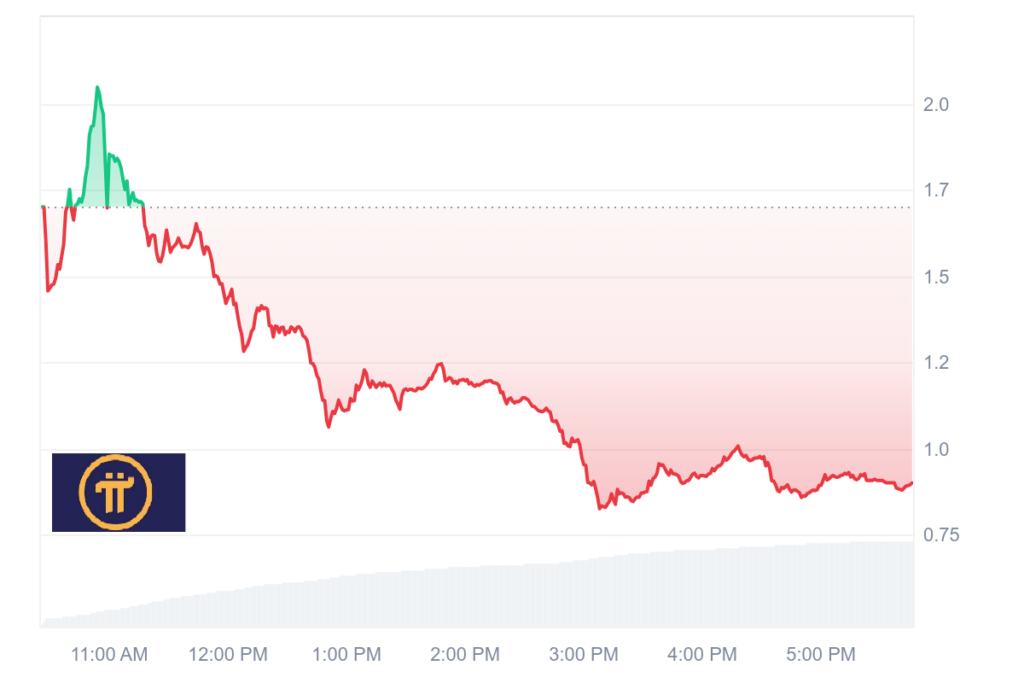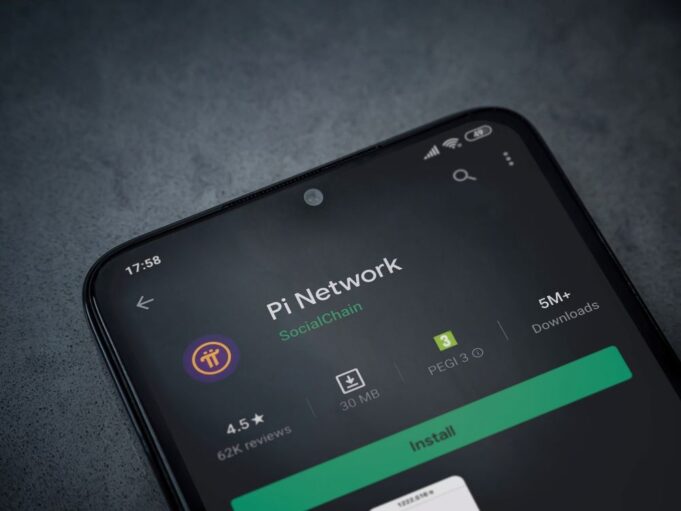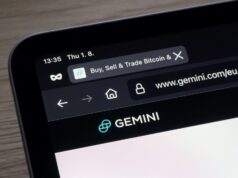The much-anticipated launch of Pi Network’s Open Mainnet on February 20, 2025, has captivated the attention of the cryptocurrency community and beyond. With a user base exceeding 60 million, Pi Network has positioned itself as a unique project aiming to democratize cryptocurrency mining through mobile devices. The Open Mainnet’s debut enabled Pi Coin (PI) to trade on major cryptocurrency exchanges. That’s a significant milestone in the project’s roadmap. However, the market debut of Pi Coin has been marked by extreme price volatility, underscoring the complexities and challenges that lie ahead.
Market Volatility and Investor Sentiment
Dramatic price fluctuations characterized the immediate aftermath of Pi Coin’s market introduction. PI opened trading at approximately $1.70, surged briefly to $2.00 amid initial investor enthusiasm, but quickly fell to around $0.97 within hours. At its peak, Pi Coin’s fully diluted valuation soared to $195 billion, briefly surpassing established players like Solana (SOL). Such volatility has been attributed to the token’s limited liquidity on crypto exchanges. Market depth reports from platforms like OKX indicated available liquidity ranging from $33,000 to $60,000, amplifying price swings from speculative trading activity.

This volatility has evoked mixed reactions. Early adopters, many of whom have been mining Pi via the mobile app for several years, view the mainnet launch as a vindication of their patience and commitment. Meanwhile, more seasoned traders have voiced concerns over the coin’s sustainability and real-world value, citing its initial hype-driven surge and subsequent sell-offs. The disparity between community enthusiasm and market skepticism highlights the tension between Pi Network’s grassroots-driven growth and the realities of open market dynamics.
Pi Network’s Mission: Redefining Accessibility in Cryptocurrency
Founded in 2019 by Stanford University Ph.D. graduates Nicolas Kokkalis and Chengdiao Fan, Pi Network was conceived to make cryptocurrency mining accessible to a global audience. Traditional cryptocurrency mining often requires specialized hardware and consumes vast amounts of electricity, creating significant barriers to entry. Pi Network addresses these issues. It enables users to mine PI directly from their smartphones without draining battery life or requiring constant connectivity.
This innovative approach leverages a modification of the Stellar Consensus Protocol (SCP) and incorporates “trust circles” to enhance network security. By decentralizing the mining process and making it more environmentally friendly, Pi Network appeals to users interested in sustainable alternatives to traditional proof-of-work systems like Bitcoin. 110 million app downloads to date signal widespread interest in the project’s vision.
Navigating Market Challenges: Real-World Utility and Sustainability
Despite its large community and ambitious mission, Pi Network faces considerable hurdles in proving the long-term utility and value of its native token. Before the Open Mainnet launch, Pi Coin was subject to speculative trading through IOUs (I Owe You contracts) on certain exchanges. There, prices were often inflated without official backing. The subsequent market correction following the official launch exposed the disconnect between speculative valuations and actual market demand.
A critical challenge for Pi Network moving forward will be developing a robust ecosystem that encourages real-world use cases for PI. While the project has announced plans for a decentralized marketplace and various applications within its ecosystem, concrete implementations remain limited so far. Without practical use cases beyond trading and speculation, sustaining long-term demand for PI could prove difficult.
Investor caution is also fueled by regulatory uncertainties. Pi Network has emphasized that its tokens are not intended for speculative trading until official exchanges list them with project approval. However, the flurry of unofficial listings and subsequent market volatility underscore the complexities of controlling token distribution in an open market environment.
Community Strength vs. Market Realities
One of Pi Network’s most distinguishing features is its community-driven growth. The project’s referral-based user acquisition strategy has successfully attracted millions worldwide, particularly in regions with limited access to traditional financial infrastructure. This grassroots approach has fostered a sense of inclusivity and democratization within the network. It aligned with blockchain’s broader promise of financial empowerment.
However, critics argue that Pi Network’s growth model bears similarities to multi-level marketing (MLM) schemes. They voice concerns about sustainability once user growth plateaus. Additionally, while the project has achieved impressive user adoption, transitioning from a mined but non-transferable token to a fully tradable asset introduces new challenges. Managing the expectations of millions of early adopters eager to monetize their holdings while ensuring long-term network integrity will be a delicate balancing act.
Technological and Societal Implications
Pi Network’s emphasis on accessibility and eco-conscious mining speaks to a broader trend within the blockchain industry: the push toward inclusivity and sustainability. Pi Network created opportunities for individuals previously excluded from the digital asset economy through lower technical and financial barriers to entry. Mobile-based mining offers an alternative path to financial participation in regions with limited banking infrastructure.
However, accessibility alone may not suffice to secure the project’s longevity. The blockchain space is increasingly competitive, with numerous projects vying for market share and user engagement. Pi Network must deliver tangible products and services to stand out. It must leverage its extensive user base beyond mere token distribution.
Furthermore, as the cryptocurrency industry continues to attract regulatory scrutiny, Pi Network’s global reach presents both opportunities and challenges. Successfully navigating different jurisdictions while adhering to evolving compliance standards will be crucial in establishing credibility within the broader financial ecosystem.
Looking Ahead: Opportunities and Risks
The Pi Network Open Mainnet launch represents both a significant achievement and a critical inflection point for the project. On one hand, the ability to trade PI on major exchanges validates years of community-building and technological development. On the other, the initial volatility and market uncertainty expose the need for clear use cases, regulatory clarity, and sustainable economic models.
For early adopters, the mainnet launch offers an opportunity to capitalize on their mined holdings. Yet, the broader investment community remains cautious, mindful of the speculative fervor that has characterized many crypto launches. The coming months will be pivotal as Pi Network works to convert its vast user base into a thriving, utility-driven ecosystem.
>>> Read more: Unveiling the Power of Shiba Inu Blockchain in Public Governance
Ultimately, Pi Network’s success will hinge on its ability to balance grassroots enthusiasm with market discipline, technological innovation with regulatory compliance, and accessibility with long-term sustainability. As the cryptocurrency landscape evolves, Pi Network stands at the crossroads of promise and peril. Its journey is a litmus test for the viability of large-scale, community-focused blockchain projects.
Readers’ frequently asked questions
How can I buy or sell Pi Coin (PI) now that the mainnet is live?
To buy or sell Pi Coin (PI) after the mainnet launch, you need to use one of the cryptocurrency exchanges officially listing the token. Platforms like OKX, Bitget, and MEXC have made PI available for trading. First, create an account on one of these exchanges, complete the required identity verification (KYC), and deposit funds (usually in USDT or another stablecoin). You can then search for the PI trading pair (e.g., PI/USDT) and place a buy or sell order. If you’ve mined PI through the Pi Network app, you’ll need to complete the in-app KYC process to transfer your mined coins to an external wallet or exchange account. Keep in mind that prices have been volatile. It’s essential to approach trading cautiously and consider transaction fees and withdrawal limitations on different platforms.
Can I still mine Pi Coin on my phone, and is it worth starting now?
Yes, you can still mine Pi Coin using the Pi Network mobile app. The app is available on both iOS and Android devices. Mining PI through the app remains free and doesn’t consume significant battery power or data. New users can join the network by downloading the app and entering an invitation code from an existing user. However, the mining rate has decreased as the network’s user base has grown. It will continue decreasing over time. Whether it’s worth starting now depends on your expectations. Mining PI requires minimal effort, but the long-term value of the coin remains uncertain. If Pi Network successfully develops practical use cases for the coin and expands its ecosystem, the mined coins could gain more value. Still, there’s no guarantee of significant financial returns.
What can I do with Pi Coin besides trading it on exchanges?
Currently, the primary use case for Pi Coin is trading it on cryptocurrency exchanges. However, Pi Network aims to build an ecosystem where PI can be used for real-world applications. That would include purchasing goods and services through its decentralized marketplace and participating in decentralized apps (dApps) built on the network. Some community-driven initiatives within the Pi Network have started experimenting with local marketplaces and peer-to-peer services using PI as a payment method. These use cases are still in the early stages, and widespread acceptance is limited at this point. The project’s future utility will depend on how quickly developers and businesses integrate PI into their platforms and whether regulatory compliance can be maintained across different regions. If Pi Network achieves its vision, holding PI could eventually provide more options beyond just trading.
What Is In It For You? Action Items You Might Want to Consider
Watch for Liquidity Improvements Before Entering Large Positions
Pi Coin’s early trading days are marked by significant volatility and limited liquidity. If you’re considering trading PI, it’s wise to monitor order book depth and trading volume on exchanges like OKX and Bitget. Jumping into large positions in thin markets can lead to substantial slippage. Wait for liquidity to stabilize—this often happens once the initial hype subsides and more market makers step in.
Leverage Short-Term Volatility for Quick Trades—but Stay Cautious
The dramatic price swings following Pi’s mainnet launch present opportunities for short-term gains. If you’re a day trader, consider setting up volatility-based strategies, like scalping or range trading. Use tight stop-loss orders to manage downside risk. Just remember: while volatility can be profitable, Pi’s market is still speculative. Don’t let FOMO dictate your trades—plan your entries and exits carefully.
Keep an Eye on Ecosystem Developments for Long-Term Value
While speculative trading is the current play, real utility will determine Pi’s staying power. Follow Pi Network’s ecosystem announcements—especially updates on dApps, partnerships, or merchant adoption. If practical use cases for PI emerge, early positioning could pay off in the long run. On the flip side, if development stalls, holding onto PI may become less attractive. Stay informed and be ready to adjust your strategy accordingly.










